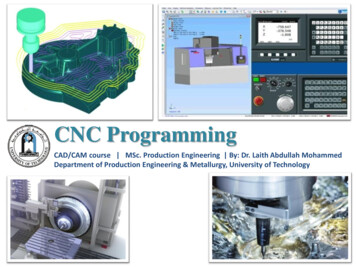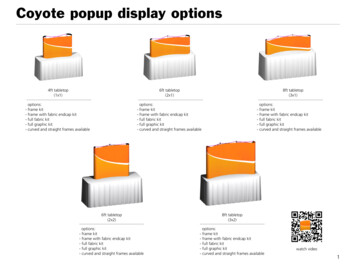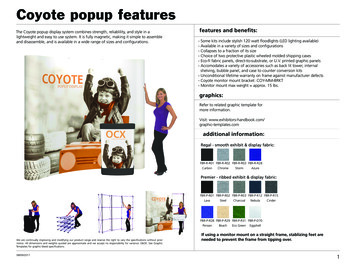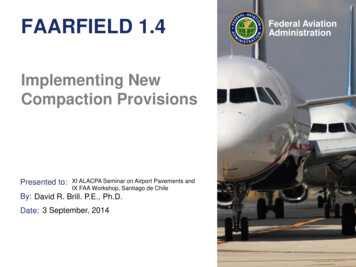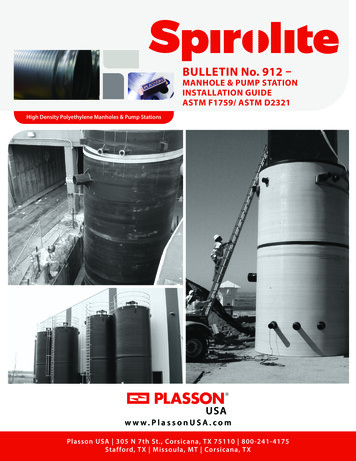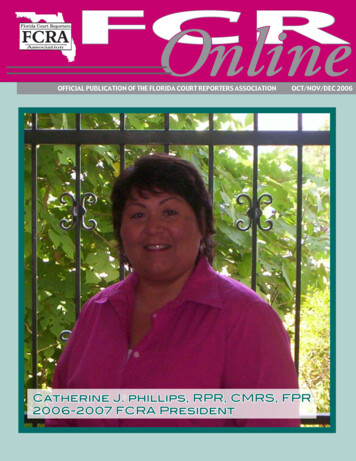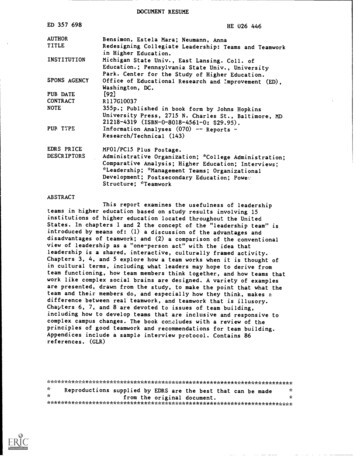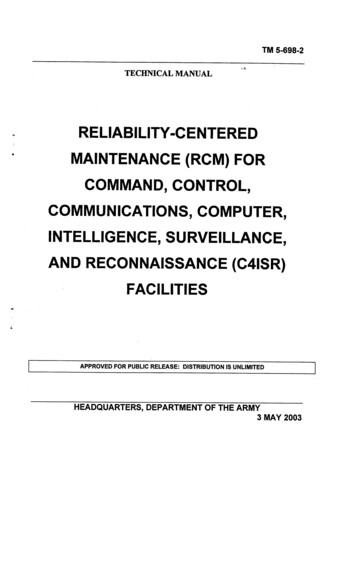
Transcription
TM 5-698-2.7kTECHNICAL MANUALRELIABILITY-CENTEREDMAINTENANCE (RCM) FORCOMMAND, CONTROL,COMMUNICATIONS, COMPUTER,INTELLIGENCE, SURVEILLANCE,AND RECONNAISSANCE (C41SR)FACILITIESAPPROVED FOR PUBLIC RELEASE : DISTRIBUTION IS UNLIMITEDHEADQUARTERS, DEPARTMENT OF THE ARMY3 MAY 2003
TM 5-698-211REPRODUCTION AUTHORIZATION/RESTRICTIONSThis manual has been prepared by or for the Government and, except to the extent indicated below, is public property and not subject to copyright . Reprint or republicationof this manual should include a credit substantially as follows : "Department of theArmy, TM 5-698-2, Reliability-Centered Maintenance (RCM) for Command, Control,Communications, Computer, Intelligence, Surveillance, and Reconnaissance (C4ISR)Facilities, 3 May 2003."N
TM 5-698-2Technical ManualNo. 5-698-2HEADQUARTERSDEPARTMENT OF THE ARMYWashington, DC, 3 May 2003APPROVED FOR PUBLIC RELEASE : DISTRIBUTION IS UNLIMITEDRELIABILITY-CENTERED MAINTENANCE (RCM) FOR COMMAND,CONTROL, COMMUNICATIONS, COMPUTER, INTELLIGENCE,SURVEILLANCE, AND RECONNAISSANCE (C4ISR) FACILITIESCONTENTSParagraph PageCHAPTER 1 . INTRODUCTION TO RELIABILITY-CENTERED MAINTENANCEPurposeScopeReferencesAvailability, maintenance, and reliabilityThe reliability-centered maintenance (RCM) conceptBenefits of RCMOrigins of RCMRelationship of RCM to other disciplinesCHAPTER 2 . ESSENTIAL ELEMENTS OF A SUCCESSFUL RCM PROGRAMR.CM implementation planData collection requirementsData analysisCommitment to life cycle support of the programRCM as a part of designFocus on the four WsCHAPTER 3 . MAINTENANCE OF SYSTEMSIntroductionCategories of maintenanceCategorization by when maintenance is performedMaintenance conceptsPackaging a maintenance programCHAPTER 4 . FUNDAMENTAL CONCEPTS OF A RELIABILITY-CENTEREDMAINTENANCE PROGRAMObjectives of RCMApplicability of preventive maintenanceFailureReliability modeling and analysisCHAPTER 5 . THE RELIABILITY-CENTERED MAINTENANCE PROCESSOverviewC4ISR candidates for RCM analysisRCM data sourcesPM tasks under RCMThe RCM processSpecific considerations for implementing RCM for C4ISR facilitiesEvaluation of -15-25-35-45-55-65-75-15-15-25-35-45-245-25i
TM 5-698-2CONTENTSParagraphPageCHAPTER 6. CONTRACTING FOR MAINTENANCEIntroduction to maintenance contractingApproach for C4ISR facilitiesMeasures of performanceScope of the contractMonitoring performanceIncentivesAPPENDIX A REFERENCESAPPENDIX B STATISTICAL DISTRIBUTION USED IN RELIABILITY ANDMAINTAINABILITYIntroduction to statistical distributionThe exponential distributionThe weibull distributionThe normal distributionThe lognormal distributionAPPENDIX C AVAILABILITY AND OPERATIONAL READINESSAvailabilityOperational 6-3B-1B-2B-3B-4B-5B-1B- iB-2B-3B-4C-1C-2C-1C-4LIST OF 45-55-65-75-85-95-105-115-125-135-146-1iiTitleCost benefits of using RCM for developing PM programData sources for the RCM analysisNon-destructive inspection (NDI) techniques, brieflyExamples of failure mechanisms and modesExamples of failure effect categorizationExamples of tasks under two categories of preventive maintenanceExamples of effects of operational failuresMethods for modeling reliabilityKey features of the GO methodCriteria for applying RCM to productsTypes of mechanical systems typical for a C4ISR facilityTypical components comprising the C4ISR facility electrical systemTypical components for a SCADA systemGeneral data sources for the RCM analysisPotential sources of C41SR maintainability dataUnderstanding and using different sources of dataNDI techniquesInformation needed for RCMExample of identified tasksPackaging the tasks from table 5-4Typical questions addressed by a reliability assessmentSteps in design tradesTypical costs considered in cost-benefit analysisExamples of positive 5-25-25-35-35-55-75-225-225-235-265-276-3
TM 5-698-2CONTENTSLIST OF -35-45-55-65-7TitleThe RCM process starts in the design phase and continues for the life ofthe systemApplicability of age limit depending on failure patternMajor categories of maintenance by when performedTypical approach to categorizing maintenance by where it is performed .An example of packaging PM tasksExample of how PM cards can be used to document required PM tasks .Block diagram of a simple redundant systemExample of a reliability block diagramExample of a fault tree (from RAC Fault Tree Analysis ApplicationGuide)Example of a single line diagram (from IEEE Gold BookStandard Network)Data elements from FMEA that are applicable to RCM analysisRCM decision logic tree (adapted from MSG-3)Evident failure - hazardous effectsEvident failure - operational effectsEvident failure - economic effectsHidden failure - hazardous effectsHidden failure - non-hazardous 135-155-175-195-21VIII
TM 5-698-2CHAPTER IINTRODUCTION TO RELIABILITY-CENTERED MAINTENANCE1-1 . PurposeThe purpose of this technical manual is provide facility managers with the information and procedures necessary todevelop and update a preventive maintenance (PM) program for their facilities that is based on the reliabilitycharacteristics of equipment and components and cost . Such a PM program will help to achieve thehighest possiblelevel of facility availability at the minimum cost .1-2 . ScopeThe information in this manual reflects the commercial practices and lessons learned over many years of developingcost-effective preventive maintenance programs for a wide variety of systems and equipment . It specifically focuseson developing PM programs for electrical and mechanical systems used in command, control, communications,computer, intelligence, surveillance, and reconnaissance (C41SR) facilities based on the reliability characteristics ofthose systems and economic considerations, while ensuring that safety is not compromised . The process fordeveloping such a PM program is called Reliability-Centered Maintenance, or RCM . Two appendices develop keytopics more deeply: appendix B, statistical distribution; and appendix C, availability .1 .3. ReferencesAppendix A contains a complete list of references used in this manual .1-4. Availability, maintenance, and reliabilityIn addition to the following key terms, the glossary lists acronyms, abbreviations, and additional definitions forterms used in this document . Additional terms are included to help the reader better understand the conceptspresented herein .a . Availability. (Also see appendix C). Availability is defined as the probability that a system or product will beavailable to perform its intended mission or function when called upon to do so at any point in time . It can bemeasured in one of several ways .(1) Function of uptime. Availability can be considered as the percent of total time that a system is available . Itis measured using equation I (note that the period of time over which this measure of availability is made must bedefined). .Downtime includes administrative time and delays, as well as time for maintenance and repair .Availability UptimeDowntime Uptime ( Total Time)Equation 1(2) Operational availability . Another equation for availability directly uses parameters related to the reliabilityand maintainability characteristics of the item as well as the support system. Equation 2 reflects this measure.AvailabilityMean Time Between Maintenance (MTBM)Mean Downtime MTBMEquation 2IV1 -1
TM 5-698-2(3) Inherent availability. In equation 2, MTBM includes all maintenance required for any reason, includingrepairs of actual design failures, repairs of induced failures, cases where a failure cannot be confirmed, andpreventive maintenance . When only maintenance required to correct design failures are counted and the effects ofthe support system are ignored, the result is inherent availability, which is given by equation 3 .Availability Mean Time Between Failure (MTBF)Equation 3Mean Time to Repair MTBFb. Maintenance. Maintenance is defmed as those activities and actions that directly retain the proper operation ofan item or restore that operation when it is interrupted by failure or some other anomaly . (Within the context ofRCM, proper operation of an item means that the item can perform its intended function .) These activities andactions include removal and replacement of failed items, repair of failed items, lubrication, servicing (includesreplenishment of consumables such as fuel), and calibrations . Other activities and resources are needed to supportmaintenance . These include spares, procedures, labor, training, transportation, facilities, and test equipment . Theseactivities and resources are usually referred to as logistics . Although some organizations may define maintenance toinclude logistics, it will be used in this TM in the more limited sense and will not include logistics .(I) Corrective maintenance. Corrective maintenance is maintenance required to restore a failed item to properoperation. Restoration is accomplished by removing the failed item and replacing it with a new item, or by fixingthe item by removing and replacing internal components or by some other repair action .(2) Preventive maintenance . Scheduled maintenance or maintenance performed based on the condition of anitem conducted to ensure safety, reduce the likelihood of operational failures, and obtain as much useful life aspossible from an item .(3) Condition-based maintenance . Condition-based maintenance can be performed on the basis of observedwear or on predicting when the risk of failure is excessive .(a) Some items exhibit wear as they are used . If the probability of failure can be related to a measurableamount of wear, it may be possible to prescribe how much wear can be tolerated before the probability of failurereaches some unacceptable level . If so, then this point becomes the criterion for removal or overhaul . Measurementcan be done using a variety of techniques depending on the characteristic being measured . The length of cracks instructures, for example, can be measured using x-ray and ultrasound.(b) In predictive maintenance, a given operating characteristic of the item, vibration or temperature, forexample, is trended and compared with the known "normal" operating levels . An acceptable range is establishedwith either upper and lower limits, or some maximum or minimum level . As long as the trend data remain inside theacceptable level, any variation is considered to be normal variation due to variances in materials, operatingenvironment, and so forth . When the trend line intersects the "unacceptable" limit line, preventive maintenance isrequired to prevent a failure in the future . The limits are based on knowledge of the normal operating characteristicsand the level of risk of failure we are willing to accept .c . Reliability. The probability that an item will perform its intended function(s) without failure for a specifiedtime under stated conditions .d . Reliability-centered maintenance (RCM) . RCM is a logical, structured framework for determining theoptimum mix of applicable and effective maintenance activities needed to sustain the operational reliability ofsystems and equipment while ensuring their safe and economical operation and support . Although RCM focuses onidentifying preventive maintenance actions, corrective actions are identified by default . That is, when no preventiveaction in effective or applicable for a given item, that item is run to failure (assuming safety is not at issue) . Fromthat perspective, RCM identifies all maintenance . RCM is focused on optimizing readiness, availability, andsustainment through effective and economical maintenance .1-2
TM 5-698-21-5 . The reliability-centered maintenance conceptPrior to the development of the RCM methodology, it was widely believed that everything had a "right" time forsome form of preventive maintenance (PM), usually replacement or overhaul . A widespread belief among manymaintenance personnel was that by replacing parts of a product or overhauling the product (or reparable portionsthereof), that the frequency of failures during operation could be reduced . Despite this previous commonly heldview, the results seemed to tell a different story. In far too many instances, PM seemed to have no beneficial effects .Indeed, in many cases, PM actually made things worse by providing more opportunity for maintenance-inducedfailures.a. Airline study. When the airline companies in the United States observed that PM did not always reduce theprobability of failure and that some items did not seem to benefit in any way from PM, they formed a task force withthe Federal Aviation Administration (FAA) to study the subject of preventive maintenance . The results of the studyconfirmed that PM was effective only for items having a certain pattern of failures . The study also concluded thatPM should be required only when required to assure safe operation . Otherwise, the decision to do or not do PMshould be based on economics .b. RCM approach. The RCM approach provides a logical way of determining if PM makes sense for a givenitem and, if so, selecting the appropriate type of PM . The approach is based on the following precepts .(1) The objective of maintenance is to preserve an item's function(s) . RCM seeks to preserve system orequipment function, not just operability for operability's sake . Redundancy improves functional reliability butincreases life cycle cost in terms of procurement and life cycle cost .(2) RCMfocuses on the end system. RCM is more concerned on maintaining system function than individualcomponent function .(3) Reliability is the basisfor decisions. The failure characteristics of the item in question must be understoodto determine the efficacy of preventive maintenance. RCM is not overly concerned with simple failure rate ; it seeksto know the conditional probability of failure at specific ages (the probability that failure will occur in each givenoperating age bracket) .(4) RCM is driven first by safety and then economics . Safety must always be preserved. When safety is not anissue, preventive maintenance must be justified on economic grounds .(5) RCM acknowledges design limitations. Maintenance cannot improve the inherent reliability - it is dictatedby design. Maintenance, at best, can sustain the design level of reliability over the life of an item .(6) RCM is a continuing process . , The difference between the perceived and actual design life and failurecharacteristics is addressed through age (or life) exploration .4c . RCM concept. The RCM concept has completely changed the way in which PM is viewed . It is now a widelyaccepted fact that not all items benefit from PM . Moreover, even when PM would be effective, it is often lessexpensive (in all senses of that word) to allow an item to "run to failure" rather than to do PM . In the succeedingdiscussions, we will examine the RCM concept in more detail. We will explore the meaning of terms that arecentral to the RCM approach . These terms include failure characteristics, efficiency, run to failure, cost, andfunction .1-6. Benefits of RCMa. Reduced costs . A significant reason for creating the aforementioned joint airline/FAA task force was the newBoeing 747 (B747) jumbo jet. Boeing and United Airlines, the initial buyer of the aircraft, were already consideringthe development of the PM program for the B747 . This new airliner was vastly larger and more complex than anyever built . Given the cost of maintenance on smaller aircraft already in service, the maintenance costs for the B747,using the traditional approach to PM, would have threatened the profitability, and hence the viability, of operatingthe new aircraft . Examples of the ultimate savings achieved in using RCM to develop the PM program for the B7471-3
TM 5-698-2and other aircraft are shown in table 1-1 . Similar savings have been achieved by other industries for otherequipment when going from a traditional to an RCM-based PM program . It is important to note that these costssavings are achieved with no reduction in safety, an obvious requirement in the airline industry .Table 1-1 . Cost benefits of using RCMfor developing PM programType of PMStructural inspectionsOverhaulOverhaul of turbine engineRequired UsingTraditional Approach4,000,000 hours or DC-8339 items fo C-8ScheduledRequired Using RCM66,000 hours for 7 77 items for DC-10On-condition (cut shop maintenancecosts by 50% compared with DC-8)b . Increased availability. For many systems, including C41SR facilities, availability is of primary importance .Availability was defined in paragraph 1-4 . As indicated in the definition, the level of availability achieved in actualuse of a product is a function of how often it fails and how quickly it can be restored to operation . The latter, inturn, is a function of how well the product was designed to be maintainable, the amount of PM required, and thelogistics resources and infrastructure that have been put in place to support the product . RCM directly contributes toavailability by reducing PM to that which is essential and economic .1-7. Origins of RCMa . Airlines . As stated earlier, RCM had its origins with the airline industry . Nowhere had the then-prevailingphilosophy of maintenance been challenged more . By the late 1950's, maintenance costs in the industry hadincreased to a point where they had become intolerable . Meanwhile, the Federal Aviation Agency (FAA) hadlearned through experience that the failure rate of certain types of engines could not be controlled by changing eitherthe frequency or the content of scheduled fixed-interval overhauls . As a result of these two factors, a task forceconsisting of representatives of the airlines and aircraft manufacturers was formed in 1960 to study the effectivenessof PM as being implemented within the airline industry .(1) The taskfbrce . The task force developed a rudimentary technique for developing a PM program .Subsequently, a maintenance steering group (MSG) was formed to manage the development of the PM program forthe new Boeing 747 (B747) jumbo jet . This new airliner was vastly larger and more complex than any ever built .Given the cost of maintenance on smaller aircraft already in service, the maintenance costs for the B747, using thetraditional approach to PM, would have threatened the profitability, and hence the viability, of operating the newaircraft .(2) MSG-1 . The PM program developed by the steering group, documented in a report known as MSG- 1, wasvery successful . That is, it resulted in an affordable PM program that ensured the safe and profitable operation ofthe aircraft .(3) MSG 2. The FAA was so impressed with MSG-1 that they requested that the logic of the new approach begeneralized, so that it could be applied to other aircraft . So in 1970, MSG-2, Airline Manufacturer MaintenanceProgram Planning Document, was issued . MSG-2 defined and standardized the logic for developing an effectiveand economical maintenance program . MSG-2 was first used on the L1011, DC 10, and MD80 aircraft. In 1972, theEuropean aviation industries issued EMSG (European Maintenance System Guide), which improved on MSG-2 inthe structures and zonal analysis . EMSG was used on the Concorde and A300 Airbus .b. Adoption by military. The problems that the airlines and FAA had experienced with the traditional approach tomaintenance were also affecting the military . Although profit was not an objective common to both the airlines andmilitary, controlling costs and maximizing the availability of their aircraft were . Consequently, in 1978, the DODcontracted with United Airlines to conduct a study into efficient maintenance programs . The study supplementedMSG-2 by emphasizing the detection of hidden failures and moved from a process-oriented concept to a taskoriented concept . The product of the study was MSG-3, a decision logic that was called Reliability-CenteredMaintenance (RCM).1 -4
TM 5-698-2c . Use for facilities and other industries . Although created by the aviation industry, RCM quickly foundapplications in many other industries. RCM is used to develop PM programs for public utility plants, especiallynuclear power plants, railroads, processing plants, and manufacturing plants . It is no overstatement to say that RCMis now the pre-eminent method for evaluating and developing a comprehensive maintenance program for an item .Today, a variety of documents are available on RCM . A listing of some of the more prominent documents isincluded in appendix A .1-8 . Relationship of RCM to other disciplinesa . Reliability. It is obvious why the first word in the title of the MSG-3 approach is reliability . Much of theanalysis needed for reliability provides inputs necessary for performing an RCM analysis, as will be seen insucceeding sections . The fundamental requirement of the RCM approach is to understand the failure characteristicsof an item . As used herein, failure characteristics include the underlying probability density function, theconsequences of failure, and whether or not the failure manifests itself and, if it does, how . Reliability is measuredin different ways, depending on one's perspective : inherent reliability, operational reliability, mission (or functional)reliability, and basic (or logistics) reliability. RCM is related to operational reliability .(I) Inherent versus operational reliability . From a designer's perspective, reliability is measured by "counting"only those failures that are design-related . When measured in this way, reliability is referred to as "inherentreliability ." From a user's or operator's perspective, all events that cause the system to stop performing its intendedfunction is a failure event . These events certainly include all design-related failures that affect the systems' function .Also included are maintenance-induced failures, no-defect found events, and other anomalies that may have beenoutside the designer's contractual responsibility or technical control . This type of reliability is called "operationalreliability."(2) Mission orfunctional reliability versus basic or logistics reliability . Any failure that causes the product tofail to perform its function or mission is counted in "mission reliability ." Redundancy improves mission reliability .Consider a case where one part of a product has two elements in parallel where only one is needed (redundant) . If afailure of one element of the redundant part of the product fails, the other continues to function allowing the productto do its job. Only if both elements fail will a mission failure occur. In "basic" reliability, all failures are counted,whether or not a mission or functional failure has occurred . This measure of reliability reflects the total demand thatwill eventually be placed on maintenance and logistics .b . Safety . Earlier, it was stated that one of the precepts on which the RCM approach is that safety must always bepreserved. Given that the RCM concept came out of the airline industry, this emphasis on ensuring safety shouldcome as no surprise . In later sections, the manner in which the RCM logic ensures that safety is ensured will bediscussed . For now, it is sufficient to note that the RCM specifically addresses safety and is intended to ensure thatsafety is never compromised. In the past several years, environmental concerns and issues involving regulatorybodies have been accorded an importance in the RCM approach for some items that is equal (or nearly so) to safety .Failures of an item that can cause damage to the environment or which result in some Federal or state law beingviolated can pose serious consequences for the operator of the item . So the RCM logic is often modified, as it is inthis TM, to specifically address environmental or other concerns .c . Maintainability. RCM is a method for prescribing PM that is effective and economical . Whether or not agiven PM task is effective depends on the reliability characteristics of the item in question . Whether or not a task iseconomical depends on many factors, including how easily the PM tasks can be performed . Ease of maintenance,corrective or preventive, is a function of how well the system has been designed to be maintainable . This aspect ofdesign is called maintainability . Providing ease of access, placing items requiring PM where they can be easilyremoved, providing means of inspection, designing to reduce the possibility of maintenance-induced failures, andother design criteria determine the maintainability of a system .u.1-5
TM 5-698-2CHAPTER 2ESSENTIAL ELEMENTS OF A SUCCESSFUL RCM PROGRAM2-1 . RCM implementation planAn overview of steps of the RCM process is shown in figure 2-1 .Design and Development PhaseIR&M .AnalyticalInputsZRCM Analysis Results fromDevelopmental TestingImplement logic treeInitial MaintenanceProgramDetermine effectivenessDetermine economical impactIdentify PM tasksPackage TasksConfiguration and OtherInputsLife Explorationr Operational Maintenanceand Failure DataiUpdated MaintenanceProgramUpdate RCM AnalysisData Analysist4iOperating and Support Phasei111 .Figure 2-1 . The RCMprocess starts in the design phase and continues for the life of the system.a . Major tasks. As shown in figure 2-1, several major tasks are required to implement the RCM concept .(1) Conduct supporting analyses . RCM is a relatively information-intensive process . To provide theinformation needed to conduct the RCM analysis, several supporting analyses are either required, often asprerequisites to beginning the RCM analysis, or desirable . These supporting analyses include the Failure Modes andEffects Analysis, ]Fault Tree Analysis, functional analysis, and others .(2) Conduct the RCM analysis . The RCM analysis consists of using a logic tree to identify effective,economical, and, when safety is concerned, required PM . (As will be seen, PM is required when safety is involved ;if no PM is effective, then redesign is mandatory) .b. The implementation plan. Planning to implement an RCM approach to defining the PM for a system orproduct must address each of the tasks noted in the preceding paragraph . The plan must address the supportingdesign phase analyses needed to conduct an RCM analysis . Based on the analysis, an initial maintenance plan,2-1
TM 5-698-2consisting of the identified PM with all other maintenance being corrective, by default, is developed . This initialplan should be updated through Life Exploration during which initial analytical results concerning frequency offailure occurrence,, effects of failure, costs of repair, etc . are modified based on actual operating and maintenanceexperience . Thus, the RCM process is iterative, with field experience being used to improve upon analyticalprojections.2-2. Data collection requirementsa . Required data. Since conducting an RCM analysis requires an extensive amount of information, and much ofthis information is not available early in the design phase, RCM analysis for a new product cannot be completeduntil just prior to production . The data falls into four categories : failure characteristics, failure effects, costs, andmaintenance capabilities and procedures .(1) Failure characteristics. Studies conducted by the MSGs and confirmed by later studies showed that PMwas effective only for certain underlying probability distributions . Components and items, for example, for which aconstant failure rate applies (e .g., the underlying probability distribution is the exponential) do not benefit from PM .Only when there is an increasing probability of failure should PM be considered .(2) Failure erects. The effects of failure of some items are minor or even insignificant . The decision whetheror not to use PM for such items is based purely on costs . If it is less expensive to allow the item to fail (and thenperform CM) to perform PM, the item is allowed to fail . As stated earlier, allowing an item to fail is called run tofailure .(3) Costs . The costs that must be considered are the costs of performing a PM task(s) for a given item, the costof performing CM for that item, and the economic penalties, if any, when an operational failure occurs .(4) Maintenance capabilities and procedures. Before selecting certain maintenance tasks, the analyst needs tounderstand what the capabilities are, or are planned, for the system . In other words, what is or will be the availableskill levels, what maintenance tools are available or are planned, and what are the diagnostics being designed into orfor the system.b . Sources ofdata. Table 2-1 lists some of the sources of data for the RCM analysis . The data elements from theFailure Modes and Effects Analysis (FMEA) that are applicable to RCM analysis are highlighted in paragraph 5-5b .Note that when RCM is being applied to a product already in use (or when a maintenance program is updated duringLife Exploration - see paragraph 5-5e), historical maintenance and failure data will be inputs for the analysis . Aneffective Failure Reporting and Corrective Action System (FRACAS) is an invaluable source of data .Table 2-1 . Data sources for the RCM analysisDataSourceLubrication requirementsRepair manualsEngineering drawingsRepair parts listsQuality deficiency reportsOther technical documentationRecorded observationsHardware block diagramsBill of MaterialsFunctional block diagramsExisting maintenance plans2-2CommentDetermined by designer . For off-the-shelf items being integrated into theproduct, lubrication requirements and instructions may be available .For off-the-shelf items being integrated into the product .For n w d off-
The reliability-centered maintenance (RCM) concept 1-5 1-3 Benefits of RCM 1-6 1-3 Origins of RCM 1-7 1-4 Relationship of RCM to other disciplines 1-8 1-5 CHAPTER 2. ESSENTIAL ELEMENTS OF A SUCCESSFUL RCM PROGRAM R.CM impleme
